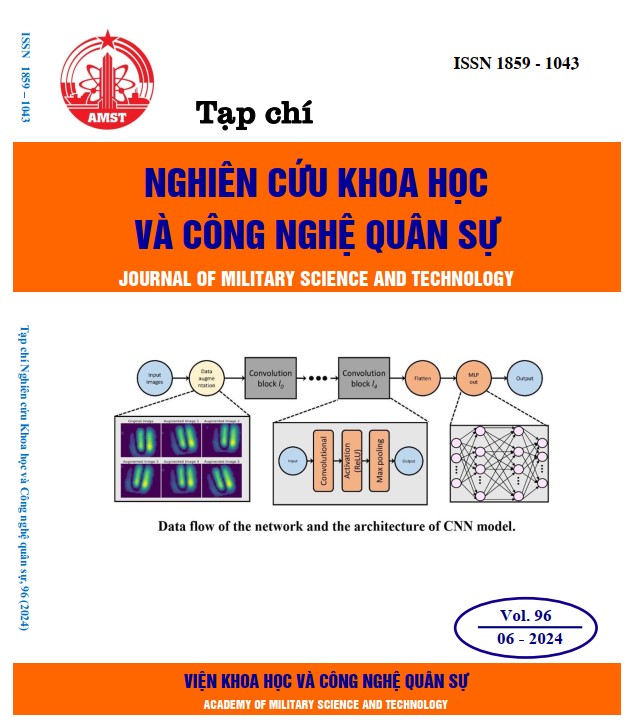Effects of cooling rate upon annealing on the microstructure and properties of the FeCo49V2Nb0.2 alloy
439 viewsDOI:
https://doi.org/10.54939/1859-1043.j.mst.96.2024.145-151Keywords:
Microstructures; Properties; FeCo49V2Nb0.2 alloy; Cooling rate; Soft magnetic alloys.Abstract
In this paper, the influence of heat treatment on the magnetic properties of permendur the FeCo49V2Nb0.2 alloy used as the rotor core of a generator is investigated. The as-cast alloy is forged, hot and cold rolled to a thickness of 0.2 mm. The alloy samples were annealed in an argon gas furnace at different cooling rates. The results of measuring properties using the vibrating sample magnetometer method and measuring hardness show that the cooling rate has a significant impact on the properties of the FeCo49V2Nb0.2 alloy. Combining X-ray diffraction analysis and microstructure analysis allows us to explain the changes in properties obtained. From the results obtained, a conclusion can be drawn about the appropriate cooling rate for this alloy to achieve the best magnetic properties.
References
[1]. E.P. Wohlfarth,“Handbook of Ferromagnetic Materials,” Vol. 2, North-Holland Publishing Company, pp. 168-170, (1980).
[2]. R.S. Sundar and S.C. Deevi,“Soft magnetic FeCo alloys: alloy development, processing, and properties,” International Materials Reviews, Vol. 50, No. 3, pp. 157-192, (2005). DOI: https://doi.org/10.1179/174328005X14339
[3]. Cohen Persiano, “Structure and physical properties of soft magnetic FeCo based alloys”, Thesis submitted for the degree of doctor of philosophy of the university of London, pp 7-9, (1986).
[4]. Cheryll Denise Pitt, “The microstructure and mechanical properties of FeCo alloys with various alloying additions,” Thesis submitted for the degree of doctor of philosophy, pp. 3-13, (1980).
[5]. M.R. Pinnel, S. Mahajan, J.E. Bennett, Acta Metall. 24, 1095, (1976). DOI: https://doi.org/10.1016/0001-6160(76)90026-2
[6]. E.P. George, A.N. Gubbi, I. Baker, L. Robertson, Mater. Sci. Eng. A329–A331, 325, (2002). DOI: https://doi.org/10.1016/S0921-5093(01)01594-5
[7]. L. Zhao, I. Baker, Acta Metall. Mater. 42, 1953, (1994). DOI: https://doi.org/10.1016/0956-7151(94)90020-5
[8]. K. Kawahara, “Structures and mechanical properties of an FeCo-2V alloy” J. Mater. Sci., Vol. 18, pp. 3427-3436, (1983). DOI: https://doi.org/10.1007/BF00544171
[9]. K. Kawahara, “Effect of cold rolling on the mechanical properties of an FeCo-2V alloy”, J. Mater. Sci., Vol. 18, pp. 3437-3448, (1983). DOI: https://doi.org/10.1007/BF00544172
[10]. Межгосударственный Стандарт, Гост 10994-74 Сплавы прецизионные. Марки
[11]. “Soft magnetic cobalt-iron alloys Vacoflux and Vacodur”, Vacuumschmelze GmbH & Co. KG, Hanau, (2016).
[12]. A.A. Couto and P.I. Ferreira, “Phase transformations and properties of Fe-Co alloys,” J. Mater. Eng.,Vol. 11, pp. 31-36, (1989). DOI: https://doi.org/10.1007/BF02833751
[13]. D.W. Clegg and R.A. Buckley, “The disorder → order transformation in Fe-Co-based alloys,” Metal science journal, Vol. 7, pp. 48-65, (1973). DOI: https://doi.org/10.1179/030634573790445541
[14]. Julia I Deitz, Timothy J Ruggles, Philip J Noell, Donald F Susan, Andrew B Kustas, Paul G Kotula, Joseph R Michael “Characterization of Anomalous Grains in FeCo Magnetic Alloys”, Microscopy and Microanalysis, Volume 29, Issue 3, pp 913–918, (2023). DOI: https://doi.org/10.1093/micmic/ozad041
[15]. D. F. Susan, A. B. Kustas, R. A. Kellogg, J. D. Carroll, J. R. Michael, I. Karaman, “The Effects of Annealing After Equal Channel Angular Extrusion (ECAE) on Mechanical and Magnetic Properties of 49Fe-49Co-2V Alloy”, Metallurgical and Materials Transactions A, Volume 52, pp 4090–4099, (2021). DOI: https://doi.org/10.1007/s11661-021-06366-7
[16]. Riipinen, T., Metsä-Kortelainen, S., Lindroos, T., Keränen, J.S., Manninen, A. and Pippuri-Mäkeläinen, J., "Properties of soft magnetic Fe-Co-V alloy produced by laser powder bed fusion", Rapid Prototyping Journal, 18 February 2019, Vol. 25 No. 4, pp. 699-707, (2019). DOI: https://doi.org/10.1108/RPJ-06-2018-0136







